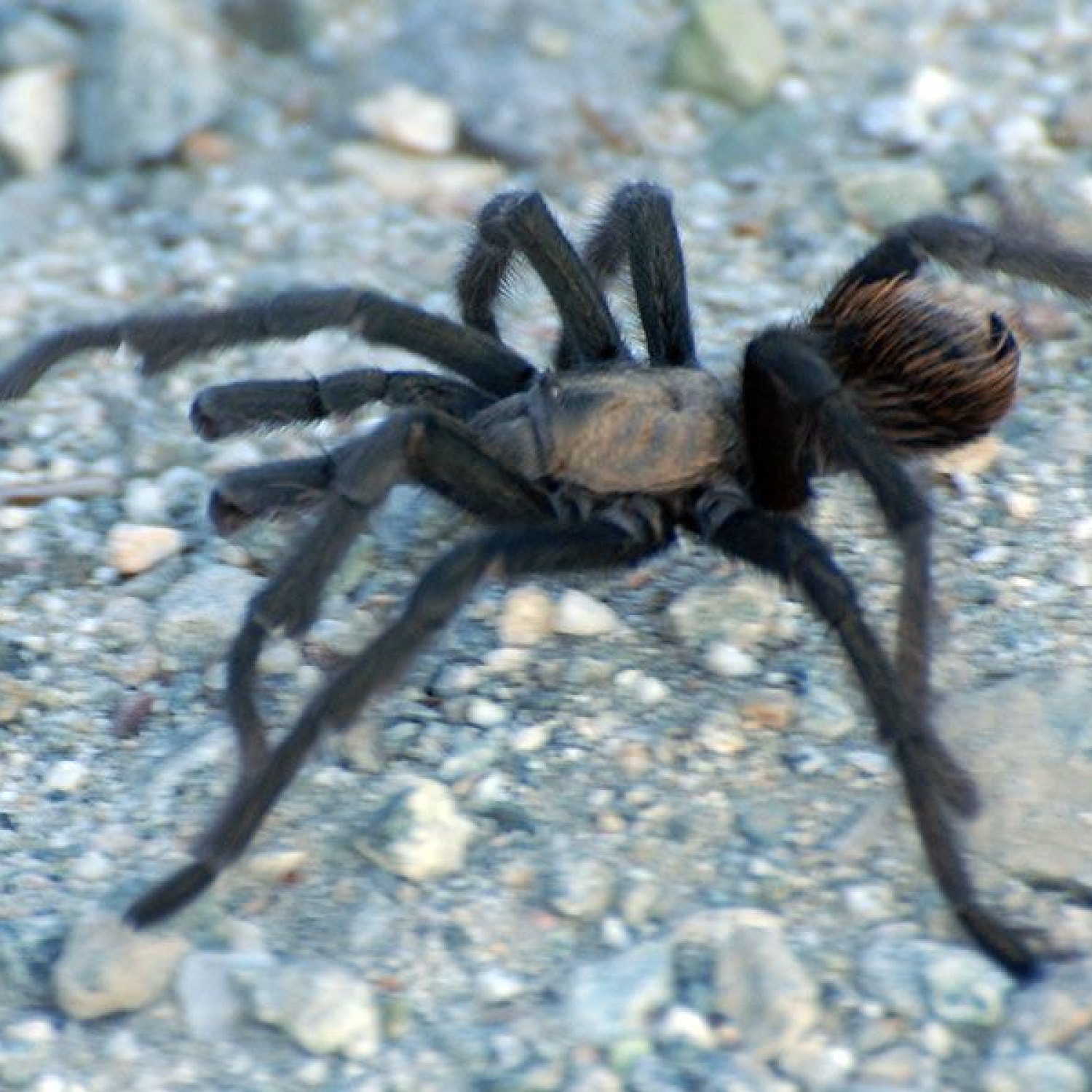
California Tarantula
The body length of California Tarantulas can range from 2 to 4 inches (5 to 10 centimeters). With their legs included, they can span up to 8 inches (20 centimeters).
Meet the California Tarantula, a fascinating creature found in California, Nevada, Oregon, and Utah. With a body length of 2-4 inches, they can span up to 8 inches with their legs. They have a large, robust body with two segments and a round, bulbous abdomen. Be sure to keep an eye out for these unique spiders on your next visit to the West Coast! #californiatarantula #westcoastwildlife #uniquecreatures
Animal Details Summary:
Common Name: California Tarantula
Kingdom: Animalia
Habitat: California Tarantulas are typically found in the grasslands, chaparral, and oak woodland areas of California. They prefer dry habitats with loose soil or gravelly areas. They often make burrows in the ground or use existing crevices to create their homes.
The Enigmatic California Tarantula: Exploring the Fascinating World of These Eight-Legged Giants
When we think of tarantulas, many of us may conjure up images of giant, hairy spiders lurking in dark corners or making their way across the desert sands. However, there is one particular species of tarantula that stands out from the rest - the California Tarantula.Also known as Aphonopelma iodius, the California Tarantula is a fascinating creature that calls the western United States its home. While they may look scary at first glance, these arachnids have a complex and intriguing nature that makes them a vital part of their ecosystem California Tarantula. So let's take a closer look at this enigmatic spider and discover what makes them so unique.
The Kingdom of California Tarantulas
California Tarantulas belong to the Animalia kingdom, the most diverse kingdom in the world. This kingdom consists of all multicellular, heterotrophic organisms with complex anatomical structures. From tiny insects to large mammals, the Animalia kingdom encompasses all the creatures we share our planet with.The Phylum of Arthropoda
The California Tarantula is a part of the Arthropoda phylum, which includes creatures such as insects, crustaceans, and spiders. This phylum is the largest in the animal kingdom, with over a million known species. Arthropods have a hard exoskeleton, segmented body, and jointed appendages, making them highly adapted to their environments.The Class of Arachnida
Classified as Arachnida, the California Tarantula is a member of the spider family. Unlike popular belief, spiders are not insects but belong to a distinct class of arthropods Crocodylomorph. Arachnids have four pairs of legs, two body segments, and no antennae. Their eight legs give them their signature image, making them easily recognizable.The Fascinating Order of Araneae
The California Tarantula's order, Araneae, is one of the largest and most diverse orders in the class Arachnida. This order includes over 45,000 species, ranging from small and delicate spiders to large, intimidating ones. Many scientists believe that the order Araneae has been on the Earth for over 380 million years, making it one of the oldest orders of animals.The Thorny Family of Theraphosidae
Belonging to the Theraphosidae family, California Tarantulas are one of the 1,000 known species of tarantulas. This family consists of the largest spiders in the world, with some species growing to a leg span of over one foot. The Theraphosidae family also includes the iconic Goliath birdeater, the largest spider in the world.The California Tarantula's Preferred Habitat
Contrary to popular belief, California Tarantulas do not live in dense rainforests or desolate deserts. They are primarily found in grasslands, chaparral, and oak woodland areas of California, Nevada, Oregon, and Utah. These spiders thrive in dry habitats with loose soil or gravelly areas. They also prefer areas with adequate vegetation and access to water sources.While California Tarantulas do not construct webs, they are skilled burrowers. They dig intricate tunnels into the soil or use existing crevices, such as animal burrows or tree roots, to create their homes. These burrows protect them from extreme temperatures, predators, and other environmental factors.
The Demon of the Night: Feeding Habits of California Tarantulas
California Tarantulas are carnivorous, meaning they feed on other living creatures to survive. They are opportunistic hunters and are known to eat insects such as crickets, grasshoppers, beetles, and caterpillars. These spiders have also been observed preying on small vertebrates like lizards and mice.Tarantulas have specialized mouthparts called chelicerae, which are used to inject venom into their prey. This venom is mainly used to subdue their prey, making it easier for them to devour it. While tarantula venom may cause discomfort to humans, it is generally not harmful to healthy adults.
Distributing the Wild West: Geographical Distribution of California Tarantulas
As their name suggests, California Tarantulas are mostly found in the western United States, particularly in California, where they are the state arachnid. They can also be found in neighboring states such as Nevada, Oregon, and Utah. These spiders have adapted to different environments, ranging from mountainous regions to more arid areas.In recent years, there has been an increase in the California Tarantula's popularity as a pet, leading to them being introduced to other parts of the world. However, scientists discourage keeping them as pets, as it can have an adverse effect on their native habitats.
The California Tarantula's True Colors
California Tarantulas have a black body with a reddish-brown abdomen, making them distinguishable from other tarantula species. What makes them truly unique is the set of distinctive hairs called urticating hairs on their abdomen. Urticating hairs can be released as a defense mechanism when the spider feels threatened. These hairs cause irritation and itching on the predator's skin, making them reluctant to continue their attack.The combination of their black body and reddish-brown abdomen, along with their urticating hairs, makes the California Tarantula a formidable opponent in the eyes of their predators.
The Robust Body of the California Tarantula
California Tarantulas have a large and robust body with eight legs, giving them their iconic spider-like appearance. They have two body segments - the cephalothorax and the abdomen. The cephalothorax is a fused head and thorax, while the abdomen is a round, bulbous shape.These spiders also have eight eyes, typically positioned in two rows of four on the cephalothorax. These eyes help them detect movement and find their prey. However, their vision is not very sharp, and they primarily rely on vibrations and chemical cues to hunt.
The Size of the California Tarantula
As with most tarantula species, the size of the California Tarantula can vary. On average, their body length ranges from 2 to 4 inches (5 to 10 centimeters). However, with their long legs included, they can span up to 8 inches (20 centimeters).Female tarantulas are generally larger than males, with some species growing to almost three times the size of a male. This size difference is believed to be a survival adaptation, as larger females can produce more eggs and have a better chance of survival.
In Conclusion, California Tarantulas may have a fearsome reputation, but they are a crucial part of their ecosystem. These eight-legged giants are fascinating creatures that have adapted to various environments over millions of years. They may not be the cuddliest creatures, but they deserve our respect and appreciation.

California Tarantula
Animal Details California Tarantula - Scientific Name: Aphonopelma iodius
- Category: Animals C
- Scientific Name: Aphonopelma iodius
- Common Name: California Tarantula
- Kingdom: Animalia
- Phylum: Arthropoda
- Class: Arachnida
- Order: Araneae
- Family: Theraphosidae
- Habitat: California Tarantulas are typically found in the grasslands, chaparral, and oak woodland areas of California. They prefer dry habitats with loose soil or gravelly areas. They often make burrows in the ground or use existing crevices to create their homes.
- Feeding Method: California Tarantulas are carnivorous and primarily feed on insects such as crickets, grasshoppers, beetles, and caterpillars. They are also known to eat small vertebrates like lizards and mice.
- Geographical Distribution: California Tarantulas are native to the western United States, specifically found in California, Nevada, Oregon, and Utah.
- Country of Origin: United States
- Location: California, Nevada, Oregon, Utah
- Animal Coloration: California Tarantulas have a black body with a reddish-brown abdomen. They have a set of distinctive hairs called urticating hairs on their abdomen, which they can release as a defense mechanism.
- Body Shape: California Tarantulas have a large and robust body with eight legs. They have two body segments - the cephalothorax and the abdomen. The abdomen is round and bulbous in shape.
- Length: The body length of California Tarantulas can range from 2 to 4 inches (5 to 10 centimeters). With their legs included, they can span up to 8 inches (20 centimeters).

California Tarantula
- Adult Size: Female California Tarantulas are larger than males. Adult females can have a body length of up to 4 inches (10 centimeters), while males are typically smaller with a body length of around 2 to 2.5 inches (5 to 6.5 centimeters).
- Average Lifespan: California Tarantulas have an average lifespan of 8 to 15 years in the wild.
- Reproduction: California Tarantulas reproduce sexually.
- Reproductive Behavior: During the mating season, male tarantulas will venture out in search of a female. If a male encounters a female, he will perform a courtship ritual to attract her. This can involve drumming his leg on the ground or vibrating his body. If the female accepts the male's advances, they will mate. After mating, the female can lay several hundred eggs, which she protects in an egg sac until they hatch.
- Sound or Call: California Tarantulas do not produce sound or calls as a form of communication.
- Migration Pattern: California Tarantulas do not migrate long distances. However, males may wander in search of a mate during the mating season.
- Social Groups: California Tarantulas are solitary animals and do not form social groups.
- Behavior: California Tarantulas are nocturnal creatures, meaning they are most active at night. During the day, they typically stay inside their burrows or hide in crevices. They are docile animals and usually avoid confrontation. When threatened, they can release urticating hairs or bite in self-defense.
- Threats: California Tarantulas face threats from habitat loss due to urbanization and agriculture. They are also often victims of roadkill. Additionally, pesticide use can have adverse effects on their populations.
- Conservation Status: California Tarantulas are not currently listed as a threatened or endangered species. However, their populations may be impacted by habitat destruction and human activities.
- Impact on Ecosystem: California Tarantulas play an important role in the ecosystem as predators of insects and small vertebrates. They help control populations of potential pests.
- Human Use: California Tarantulas are not commonly used or exploited by humans. However, some people keep them as pets.
- Distinctive Features: California Tarantulas have a black body with a reddish-brown abdomen. They have a dense coating of urticating hairs on their abdomen, which they can release as a defense mechanism. They also have two body segments - the cephalothorax and the abdomen.
- Interesting Facts: 1. Female California Tarantulas can live for several years after reaching sexual maturity, while males typically have a shorter lifespan after reaching sexual maturity. 2. California Tarantulas are known for their elaborate courtship rituals, where males perform various displays and drumming to attract females. 3. Their name 'tarantula' comes from the Italian town of Taranto, where the European tarantula species was believed to be found. 4. Despite their intimidating appearance, California Tarantulas are relatively harmless to humans. Their bite is venomous but is not lethal or medically significant unless the individual bitten has an allergic reaction. 5. California Tarantulas have poor eyesight and primarily rely on touch and vibrations to detect their prey and navigate their surroundings.
- Predator: California Tarantulas have several predators, including birds, reptiles, mammals, and other spiders.

Aphonopelma iodius
The Fascinating World of the California Tarantula
The California Tarantula (Aphonopelma hbium) is a fascinating and unique species of spider found in the southwestern United States, particularly in California. Also known as the desert tarantula or the California brown tarantula, this large and hairy arachnid has captured the curiosity and attention of many nature enthusiasts and researchers. In this article, we will dive into the world of the California tarantula, exploring its physical characteristics, behavior, role in the ecosystem, and more.Size and Lifespan
One of the most striking features of the California Tarantula is its size PeaceOfAnimals.Com. Adult females can grow up to 4 inches (10 centimeters) in body length, making them significantly bigger than males, who typically reach a body length of only 2 to 2.5 inches (5 to 6.5 centimeters). Despite their large size, California Tarantulas have a relatively long lifespan, averaging between 8 to 15 years in the wild.
Reproduction and Courtship
California Tarantulas, like most tarantula species, reproduce sexually. During the mating season, which typically occurs in the fall, male tarantulas will leave their burrows in search of a female. If a male encounters a female, he will perform an elaborate courtship ritual to attract her. This can involve drumming his leg on the ground or vibrating his body. If the female accepts the male's advances, they will mate Chinese Crested Dog.
Egg Laying and Protection
After mating, the female California Tarantula can lay several hundred eggs, which she will protect in an egg sac. Unlike many other spider species, female tarantulas are known for their incredible maternal instincts. They will guard and tend to the egg sac, keeping it safe until the eggs hatch. This can take several weeks to a few months, depending on environmental factors such as temperature and humidity.
Sound and Communication
Contrary to popular belief, California Tarantulas do not produce sound or calls as a form of communication. Instead, they rely on touch and vibrations to communicate with each other, making them particularly fascinating creatures for researchers to study.
Migration and Social Behavior
Unlike some other spider species that migrate long distances, California Tarantulas do not have a migration pattern. However, males may wander in search of a mate during the breeding season. They are solitary animals and do not form social groups. Instead, they prefer to live and hunt alone, only interacting with other spiders during the breeding season.
Nocturnal Behavior and Defense Mechanisms
California Tarantulas are nocturnal creatures, meaning they are most active at night. During the day, they can be found hiding in their burrows or crevices. They are docile animals and typically avoid confrontation. However, when threatened, they can release urticating hairs from their abdomen as a defense mechanism. These hairs can cause irritation and discomfort if they come in contact with human skin. The tarantula may also bite in self-defense, but their venom is not lethal or medically significant to humans, unless an individual has an allergic reaction.
Threats and Conservation Status
Unfortunately, California Tarantulas face several threats, including habitat loss due to urbanization and agriculture. They are also often victims of roadkill. Additionally, pesticide use can have adverse effects on their populations. Currently, the California Tarantula is not listed as a threatened or endangered species. However, their populations may be impacted by these human activities.
Ecosystem Role
California Tarantulas play an essential role in the ecosystem as predators of insects and small vertebrates. They help control the populations of potential pest species and contribute to maintaining the overall balance of the ecosystem.
Human Interaction
California Tarantulas are not commonly used or exploited by humans. However, some people do keep them as pets. Due to their docile nature and relatively low maintenance requirements, they have become popular as exotic pets for some enthusiasts. However, it is important to note that keeping a tarantula as a pet requires proper research and knowledge to provide a suitable and safe habitat for the animal.
Distinctive Features
Aside from their intimidating size and hairy appearance, California Tarantulas have several distinctive features that make them unique from other spider species. They have a black body with a reddish-brown abdomen and a dense coating of urticating hairs on their abdomen. These hairs aid in their defense mechanism. They also have two body segments, the cephalothorax, which contains their eyes, mouth, and legs, and the abdomen, which contains their organs and spinnerets used to create silk.
Interesting Facts
1. Female California Tarantulas can live for several years after reaching sexual maturity, while males typically have a shorter lifespan after reaching sexual maturity.
2. California Tarantulas are known for their elaborate courtship rituals, where males perform various displays and drumming to attract females.
3. Their name 'tarantula' comes from the Italian town of Taranto, where the European tarantula species was believed to be found.
4. Despite their intimidating appearance, California Tarantulas are relatively harmless to humans. Their bite is venomous but is not lethal or medically significant unless the individual bitten has an allergic reaction.
5. California Tarantulas have poor eyesight and primarily rely on touch and vibrations to detect their prey and navigate their surroundings.
Predators
Like any other species, California Tarantulas have several predators, including birds, reptiles, mammals, and other spiders. Their natural defense mechanisms and nocturnal behavior help protect them from these predators, but unfortunately, they still face threats in the wild from human activities.
In conclusion, the California Tarantula is a unique and fascinating creature that plays an important role in the ecosystem. Despite facing some threats, this species has managed to adapt and survive in its natural habitat. As humans, it is our responsibility to ensure that their surroundings remain safe and suitable for them to thrive. And while they may not be the cuddliest of creatures, California Tarantulas are part of the diverse and intriguing world of nature, and we must continue to appreciate and protect them.

The Enigmatic California Tarantula: Exploring the Fascinating World of These Eight-Legged Giants
Disclaimer: The content provided is for informational purposes only. We cannot guarantee the accuracy of the information on this page 100%. All information provided here may change without prior notice.












